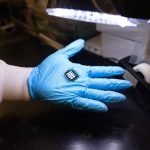New solar cell breaks records for efficiency and voltage
Scientists are introducing a new type of solar cell produced without silicon.
Scientists find way to put the brakes on lithium-ion batteries to prevent fires
New study offers a solution with a new tech that can swiftly put the brakes on a Li-ion battery, shutting it down when it gets too hot.
Scientists find way to boost the lifetimes of battery packs for electric vehicles
Stanford researchers have devised a new way to make lithium-ion battery packs last longer and suffer less deterioration from fast charging.
MIT engineers develop a low-cost terahertz camera
Terahertz radiation, whose wavelengths lie between those of microwaves and visible light, can penetrate many nonmetallic materials and detect signatures of certain molecules.
These handy...
Engineers build a battery-free, wireless underwater camera
MIT researchers develop a battery-free, wireless underwater camera that is 100,000 times more energy-efficient than other undersea cameras.
This tiny spectrometer breaks all current resolution records
We see light and colors around us every day.
However, to analyze the information it carries, we must analyze light using spectrometers, in the lab.
These...
Scientists create new tool to optimize current electric vehicle charging stations
Electric vehicle (EV) charging patterns are highly uncertain in both location, time, and duration, particularly in association with the predicted high demand for electric...
New silicon discovery could revolutionize semiconductor industry
After a 10-year research study that started by accident and was met with skepticism, a team of Northeastern University mechanical engineers was able to...
Scientists develop the world’s whitest paint ideal for vehicles
The world’s whitest paint – seen in this year’s edition of Guinness World Records and “The Late Show With Stephen Colbert” – keeps surfaces...
Scientists use modified silk to create new nonstick surfaces
Researchers have developed a method to make silk-based materials that don’t stick to water, or almost anything else that contains water.
The modified silk, which...









